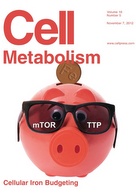
New research from the lab of Hossein Ardehali, MD, PhD, associate professor in medicine-cardiology and molecular pharmacology and biological chemistry, points toward the existence of a novel iron conservation program within cells.
The work, published in Cell Metabolism, shows how a protein governing cellular metabolism – mTOR –also regulates the cell’s balance of iron, and shows a link between metabolic, inflammatory, and iron-regulatory networks within cells.
“What we discovered was an alternative pathway in iron regulation, and this new network is activated to conserve iron inside the cell,” said Ardehali, the study’s principle investigator. “There are basically two different signals at play here. One brings iron from outside the cell into the cell and the other is mainly focused on conserving iron already there.”
An essential part of biology and present in enzymes like the ones that help humans digest food and proteins like hemoglobin, scientific knowledge of iron regulation has largely remained unchanged for decades. During low iron states, iron-regulatory proteins (IRPs) have been shown to control the nutrient by activating genes involved in transporting iron to the cell. IRP1 and IRP2 have, until now, been the only pathways linked with the process.
“For 30 years or more we have known about IRPs as the iron regulatory pathway, but it would have been very surprising for such an important co-factor like iron to be regulated by just two proteins,” said Marina Bayeva, PhD, a postdoctoral fellow in Ardehali’s lab and lead author of the paper. “Our discovery is an alternative pathway that tells cells how to use their iron wisely. We’re moving away from this model where IRPs are the only key regulators of iron and instead are looking at this process as a more complex picture.”

While the mTOR pathway also plays a role in bringing iron into the cell, its main function is seen as a mechanism for cell survival. In instances where the cell is suffering from iron starvation, it reduces the levels of proteins that require the nutrient, conserving it for use by essential proteins only. This in turn keeps the cell viable and prevents cell death.
“Our findings may potentially be important in treating iron deficiency, which affects a quarter of the world’s population,” Bayeva said. “We can’t really approach this global problem if we don’t understand how cells or organisms regulate their iron. The more we know about this process, the more we’re able to understand the pathophysiology of it and what is going on in patients. Later on, this may translate into treatments.”
Iron deficiency is the most common nutritional disorder in the world and is the only one prevalent in both developed and developing nations. The World Health Organization estimates that 2 billion people are anemic – suffering from too little hemoglobin – many due to iron deficiency.
“The challenge now is to find ways to alter this new pathway for therapeutic purposes,” Ardehali said. “We believe that iron is required for a number of diseases and it has been shown to play a role in cancer, diabetes, and heart disease. We think if this pathway is modulated it could at least partially alleviate some of the signs and symptoms associated with these disorders.”






